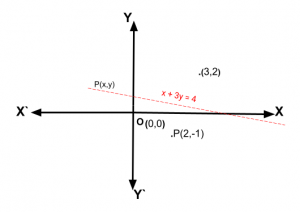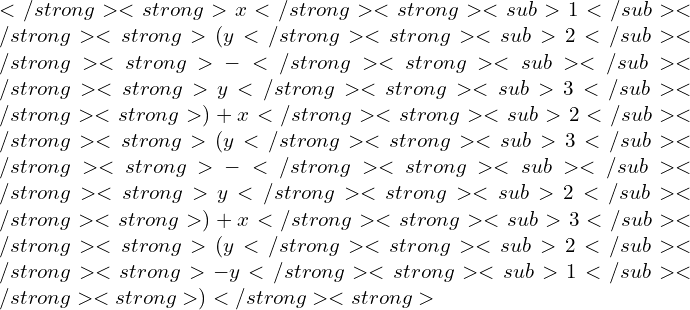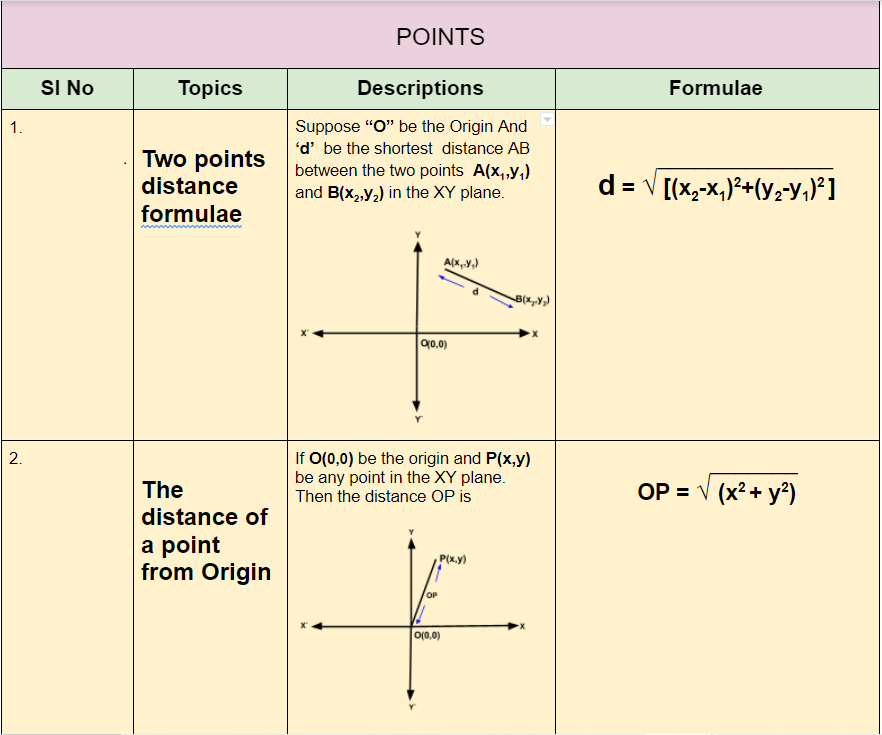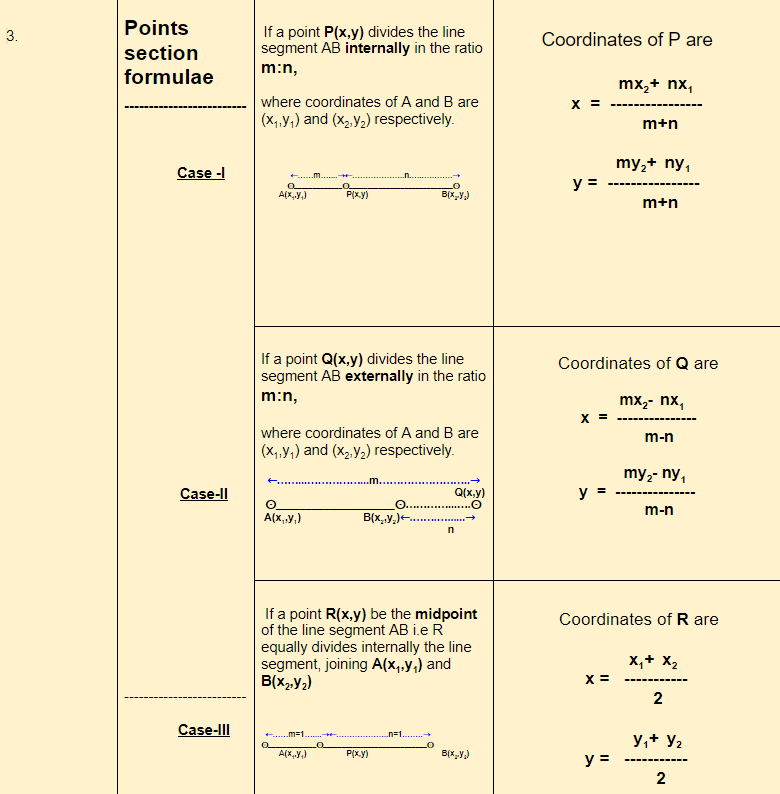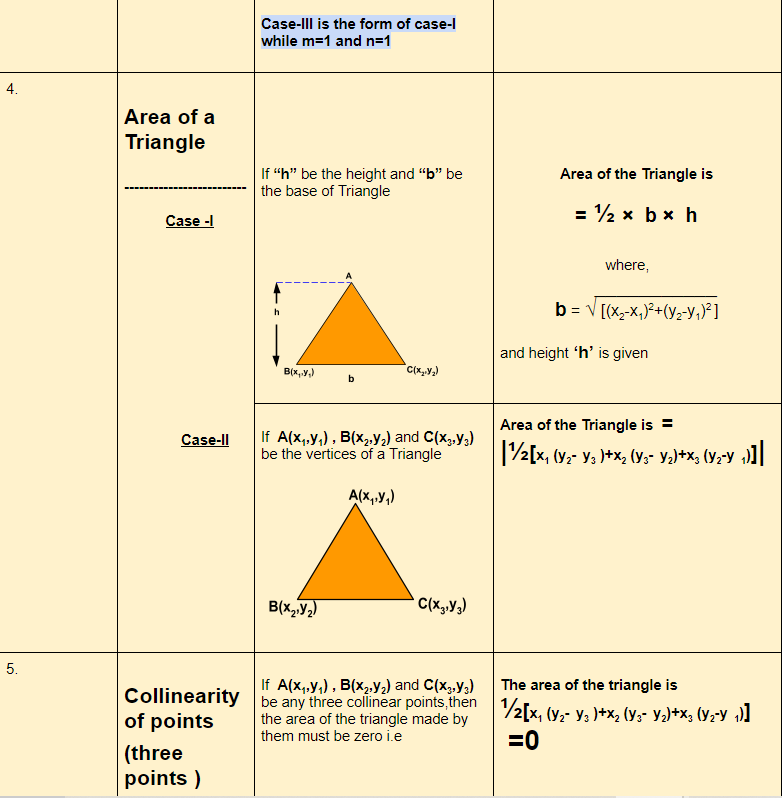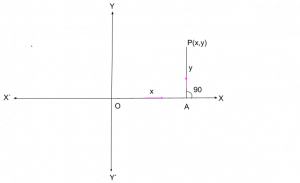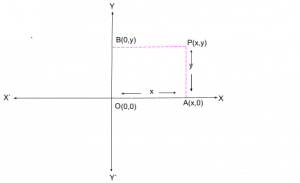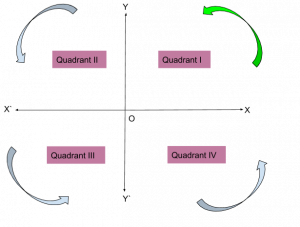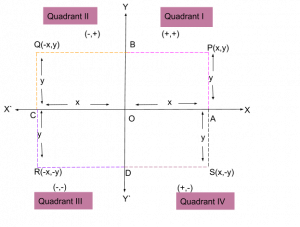Locus in 2D Coordinate Geometry
Locus is a Latin word. It is derived from the word ‘Place’ or ‘Location’. The Plural of locus is Loci.
Definition of Locus:
In Geometry, ‘Locus’ is a set of points which satisfy one or more specified conditions of a figure or shape. In modern mathematics, the location or the path on which a point moves on the plane satisfying given geometrical conditions, is called locus of the point.
Locus is defined for line, line segment and the regular or irregular curved shapes except the shapes having vertex or angles inside them in Geometry. https://en.wikipedia.org/wiki/Coordinate_system
Examples on Locus:
lines, circles, ellipse, parabola, hyperbola etc. all these geometrical shapes are defined by the locus of points.
Equation of the Locus:
The algebraic form of the geometrical properties or conditions which are satisfied by the coordinates of all the points on Locus, is known as the equation of the locus of those points.
Method of Obtaining the Equation of the Locus:
To find the equation of the locus of a moving point on a plane, follow the process described below
(i) First, assume the coordinates of a moving point on a plane be (h,k).
(ii) Second, derive a algebraic equation with h and k from the given geometrical conditions or properties.
(iii) Third, replace h and k by x and y respectively in the above said equation. Now this equation is called the the equation of the locus of the moving point on the plane. (x,y) is the current coordinates of the moving point and the equation of the locus must always be derived in the form of x and y i.e. current coordinates.
Here are some examples to make the conception clear about locus.
4+different types of solved problems on Locus:
Problem 1: If P be any point on the XY-plane which is equidistant from two given points A(3,2) and B(2,-1) on the same plane, then find the locus and the equation of locus of the point P with graph.
Solution:
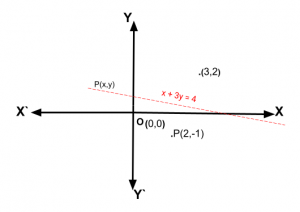
Assume that the coordinates of any point on the locus of P on XY-plane are (h, k).
Since, P is equidistant from A and B, we can write
The distance of P from A=The distance of P from B
Or, |PA|=|PB|


Or, (h2 -6h+9+k2 -4k+4) = (h2 -4h+4+k2 +2k+1)——– taking square to both sides.
Or, h2 -6h+13+k2 -4k -h2+4h-5-k2 -2k = 0
Or, -2h -6k+8 = 0
Or, h+3k -4 = 0
Or, h+3k = 4 ——– (1)
This is a first degree equation of h and k.
Now if h and k are replaced by x and y then the equation (1) becomes the first degree equation of x and y in the form of x + 3y = 4 which represents a straight line.
Therefore, the locus of the point P(h, k) on XY-plane is a straight line and the equation of the locus is x + 3y = 4 . (Ans.)
Problem 2: If a point R moves on the XY-plane in such way that RA : RB = 3:2 where the coordinates of the points A and B are (-5,3) and (2,4) respectively on the same plane, then find the locus of the point R.
What type of curve does the equation of the locus of R indicate?
Solution: Lets assume that the coordinates of any point on the locus of given point R on XY-plane be (m, n).
Asper given condition RA : RB = 3:2,
we have,
(The distance of R from A) / (The distance of R from B) = 3/2

Or, (m2 +10m+34+n2 -6n) / (m2 -4m+n2 -8n+20) =9/4 ———– taking square to both sides.
Or, 4(m2 +10m+34+n2 -6n) = 9(m2 -4m+n2 -8n+20)
Or, 4m2 +40m+136+4n2 -24n = 9m2 -36m+9n2 -72n+180)
Or, 4m2 +40m+136+4n2 -24n – 9m2 +36m-9n2 +72n-180 = 0
Or, -5m2 +76m-5n2+48n-44 = 0
Or, 5(m2+n2)-76m+48n+44 = 0 ———-(1)
This is a second degree equation of m and n .
Now if m and n are replaced by x and y, the equation (1) becomes the second degree equation of x and y in the form of 5(x2+y2)-76x+48y+44 = 0 where the coefficients of x2 and y2 are same and the coefficient of xy is zero. This equation represents a circle.
Therefore, the locus of the point R(m, n) on XY-plane is a circle and the equation of the locus is
5(x2+y2)-76x+48y+44 = 0 (Ans.)
Problem 3: For all values of (θ,aCosθ,bSinθ) are the coordinates a point P which moves on the XY plane. Find the equation of locus of P.
Solution: lets (h, k) be the coordinates of any point lying on the locus of P on XY-plane.
Then asper the question, we can say
h= a Cosθ
Or, h/a = Cosθ —————(1)
And k = b Sinθ
Or, k/b = Sinθ —————(2)
Now taking square of both the equations (1) and (2) and then adding, we have the equation
h2/a2 + k2/b2 =Cos2θ + Sin2θ
Or, h2/a2 + k2/b2 = 1 (Since Cos2θ + Sin2θ =1 in trigonometry)
Therefore the equation of locus of the point P is x2/a2 + y2/b2 = 1 . (Ans.)
Problem 4 : Find the equation of locus of a point Q, moving on the XY-plane, if the coordinates of Q are

where u is the variable parameter.
Solution : Let the coordinates of any point on the locus of given point Q while moving on XY-plane be (h, k).
Then, h =  and k =
and k = 
i.e. h(3u+2) = 7u-2 and k(u-1) = 4u+5
i.e. (3h-7)u = -2h-2 and (k-4)u = 5+k
i.e. u = —————(1)
—————(1)
and u =  —————(2)
—————(2)
Now equating the equations (1) and (2) , we get, 
Or, (-2h-2)(k-4) = (3h-7)(5+k)
Or, -2hk+8h-2k+8 = 15h+3hk-35-7k
Or, -2hk+8h-2k-15h-3hk+7k = -35-8
Or, -5hk-7h+5k = -43
Or, 5hk+7h-5k = 43
Therefore, the equation of the locus of Q is 5xy+7x-5y = 43.
More examples on Locus with answers for practice by your own:
Problems 5: If θ be a variables and u be a constant, then find the equation of locus of the point of intersection of the two straight lines x Cosθ + y Sinθ = u and x Sinθ- y Cosθ = u. ( Ans. x2+y2 =2u2 )
Problems 6: Find the equation of locus of the middle point of the line segment of the straight line x Sinθ + y Cosθ = t between the axes. ( Ans. 1/x2+1/y2 =4/t2 )
Problems 7: If a point P is moving in such way on the XY-plane that the area of the triangle made by the point with two points (2,-1) and (3,4). ( Ans. 5x-y=11)
Basic Examples on the Formulae “Centroid of a Triangle” in 2D Coordinate Geometry
Centroid: The three medians of a triangle always intersect at a point, located in the interior area of the triangle and divides the median at the ratio 2:1 from any vertex to the midpoint of the opposite side. This point is called the centroid of the triangle.
Problems 1: Find the centroid of the triangle with vertices (-1,0), (0,4) and (5,0).
Solution: We already know,
If A(x1,y1) , B(x2,y2) and C(x3,y3) be the vertices of a Triangle and G(x, y) be the centroid of the triangle, then Coordinates of G are

and

Using this formula we have ,
(x1,y1) ≌(-1,0) i.e. x1= -1, y1=0 ;
(x2,y2) ≌(0,4) i.e. x2=0, y2=4 and
(x3,y3) ≌(5,0) i.e. x3=5, y3=0
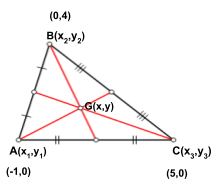
So, the x-coordinate of the centroid G, 
i.e. 
i.e. x=4/3
and
the y-coordinate of the centroid G, 
i.e 
i.e y=4/3
Therefore, the coordinates of the centroid of the given triangle is  . (Ans)
. (Ans)
More answered problems are given below for further practice using the procedure described in above problem 1 :-
Problems 2: Find the coordinates of the centroid of the triangle with vertices at the points (-3,-1), (-1,3)) and (1,1).
Ans. (-1,1)
Problems 3: What is the x-coordinate of the centroid of the triangle with vertices (5,2), (10,4) and (6,-1) ?
Ans. 7
Problems 4: Three vertices of a triangle are (5,9), (2,15) and (11,12).Find the centroid of this triangle.
Ans. (6,12)
Shifting of Origin / Translation of Axes- 2D Co-ordinate Geometry
Shifting of Origin means to shift the Origin to a new point keeping the orientation of the axes unchanged i.e the new axes remain parallel to the original axes in the same plane. By this translation of axes or shifting of origin process many problems on algebraic equation of a geometric shape are simplified and solved easily.
The formula of ” Shifting of Origin” or “Translation of Axes” are described below with graphical representation.
Formula:
If O be the origin ,P(x,y) be any point in the XY plane and O be shifted to another point O′(a,b) against which the coordinates of the point P become (x1,y1) in the same plane with new axes X1Y1 ,Then New Coordinates of P are
x1 = x- a
y1 = y- b
Graphical representation for clarification: Follow the graphs
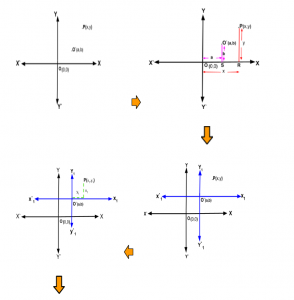
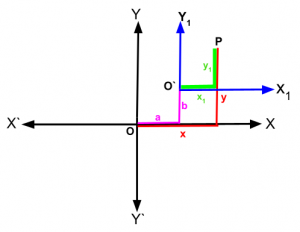
Few solved Problems on the formula of ‘Shifting of Origin’ :
Problem-1 : If there are two points (3,1) and (5,4) in the same plane and the origin is shifted to the point (3,1) keeping the new axes parallel to the original axes, then find the co-ordinates of the point (5,4) in respect with the new origin and axes.
Solution: Comparing with the formula of ‘Shifting of Origin’ described above , we have new Origin, O′(a, b) ≌ (3,1) i.e. a=3 , b=1 and the required point P, (x, y) ≌ (5,4) i.e. x=5 , y=4
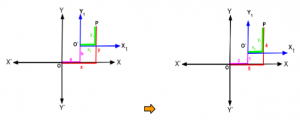
Now if (x1,y1) be the new coordinates of the point P(5,4) ,then asper formula x1 = x-a and y1 =y-b,
we get, x1 = 5-3 and y1 =4-1
i.e. x1 = 2 and y1 =3
Therefore, the required new coordinates of the point (5,4) is (2,3) . (Ans.)
Problem-2 : After shifting the Origin to a point in the same plane ,remaining the axes parallel to each other ,the coordinates of a point (5,-4) become (4,-5).Find the Coordinates of new Origin.
Solution: Here using the formula of ‘Shifting the Origin’ or ‘Translation of Axes’ , we can say the coordinates of the point P with respect to old and new Origin and axes respectively are (x, y) ≌ (5,-4) i.e. x=5 , y= -4 and (x1,y1) ≌ (4,-5) i.e. x1= 4, y1= -5
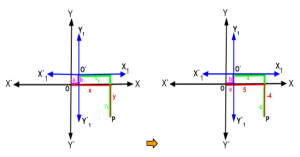
Now we have to find the coordinates of the new Origin O′(a, b) i.e. a=?, b=?
Asper formula,
x1 = x- a
y1 = y- b
i.e. a=x-x1 and b=y-y1
Or, a=5-4 and b= -4-(-5)
Or, a=1 and b= -4+5
Or, a=1 and b= 1
Therefore, O'(1,1) be the new Origin i.e. the coordinates of the new Origin are (1,1). (Ans.)
Basic Examples on the Formulae “Collinearity of points (three points)” in 2D Coordinate Geometry
Problems 1: Check whether the points (1,0), (0,0) and (-1,0) are collinear or not.
Solution: We already know,
If A(x1,y1) , B(x2,y2) and C(x3,y3) be any three collinear points, then the area of the triangle made by them must be zero i.e the area of the triangle is ½[x1 (y2– y3) + x2 (y3– y1) + x3 (y1-y2)] =0
Using this formula we have ,
(x1,y1) ≌(-1,0) i.e. x1= -1, y1= 0 ;
(x2,y2) ≌(0,0) i.e. x2= 0, y2= 0;
(x3,y3) ≌(1,0) i.e. x3= 1, y3= 0
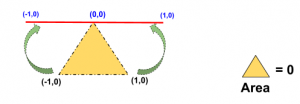
So, the area of the triangle is = |½[x1 (y2– y3) + x2 (y3– y1) + x3 (y1-y2)]| i.e.
(L.H.S) = |½[-1 (0-0) + 0 (0-0) + 1 (0-0)]|
= |½[(- 1)x0 + 0x0 + 1×0]|
= |½[0 + 0 + 0]|
= |½ x 0|
= 0 (R.H.S)
Therefore, the area of the triangle made by those given points become zero which means they are lying on the same line.
Therefore, the given points are collinear points. (Ans)
More answered problems are given below for further practice using the procedure described in the above problem 1 :-
Problems 2: Check whether the points (-1,-1), (0,0) and (1,1) are collinear or not.
Ans. Yes
Problems 3: Is it possible to draw one line through three points (-3,2), (5,-3) and (2,2) ?
Ans.No
Problems 4: Check whether the points (1,2), (3,2) and (-5,2),connected by lines, can form a triangle in the coordinate plane.
Ans. No
______________________________
Basic Examples on the Formulae “Incenter of a Triangle” in 2D Coordinate Geometry
Incenter:It is the center of the triangle’s largest incircle which fits inside the triangle.It is also the point of intersection of the three bisectors of the interior angles of the triangle.
Problems 1: The vertices of a triangle with sides are (-2,0), (0,5) and (6,0) respectively. Find the incenter of the triangle.
Solution: We already know,
If A(x1,y1) , B(x2,y2) and C(x3,y3) be the vertices, BC=a, CA=b and AB=c , G′(x,y) be the incentre of the triangle,
The co-ordinates of G′ are

and

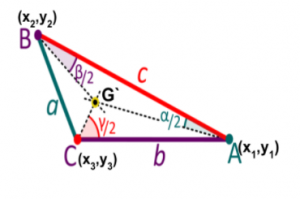
Asper the formula we have,
(x1,y1) ≌(-4,0) i.e. x1= -4, y1=0 ;
(x2,y2) ≌(0,3) i.e. x2=0, y2=3 ;
(x3,y3) ≌(0,0) i.e. x3=0, y3=0
We have now,
a= √ [(x2-x1)2+(y2-y1)2 ]
Or, a= √ [(0+4)2+(3-0)2 ]
Or, a= √ [(4)2+(3)2 ]
Or, a= √ (16+9)
Or, a= √25
Or, a = 5 ——————(1)
b=√ [(x1-x3)2+(y1-y3)2 ]
Or, b= √ [(-4-0)2+(0-0)2 ]
Or, b= √ [(-4)2+(0)2 ]
Or, b= √ (16+0)
Or, b= √16
Or, b= 4 ——————–(2)
c= √ [(x3-x2)2+(y3-y2)2 ]
Or, c= √ [(0-0)2+(0-3)2 ]
Or, c= √ [(0)2+(-3)2 ]
Or, c= √ (0+9)
Or, c= √9
Or, c= 3 ——————–(3)
and ax1+ bx2 + cx3 = (5 X (-4)) + (4 X 0) + (3 X 6 )
= -20+0+18
Or, ax1+ bx2 + cx3 = -2 ——————-(4)
ay1+ by2+ cy3 = (5 X 0) + (4 X 3) + (3 X 0)
= 0+12+0
Or, ay1+ by2+ cy3 = 12 ——————–(5)
a+b+c = 5+4+3
Or, a+b+c = 12 ——————(6)
Using the above equations (1), (2), (3), (4), (5) and (6) we can calculate the value of x and y from

Or, x = -2/12
Or, x = -1/6
and

Or, y = 12/12
Or, y = 1
Therefore the required coordinates of the incenter of the given triangle are (-1/6 , 1). (Ans.)
More answered problems are given below for further practice using the procedure described in above problem 1 :-
Problems 2: Find the coordinates of the incenter of the triangle with vertices at the points (-3,-1), (-1,3)) and (1,1).
Problems 3: What is the x-coordinate of the incenter of the triangle with vertices (0,2), (0,0) and (0,-1) ?
Problems 4: Three vertices of a triangle are (1,1), (2,2) and (3,3). Find the incenter of this triangle.
